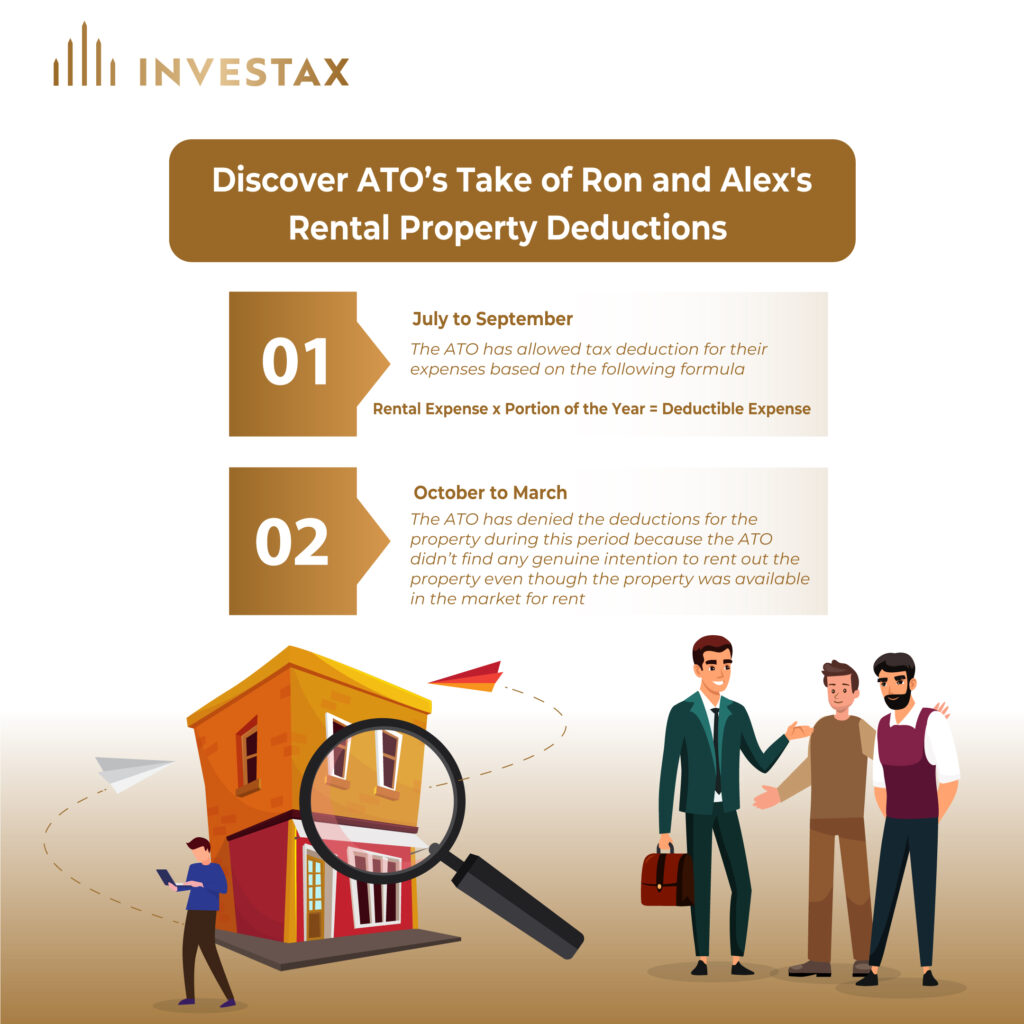ATO’s Rental Property Deductions: Ron & Alex
Overview
Ron and Alex, both successful in their careers and passionate about property investment, cherish their beach walks over tax paperwork. They rely on their accountant for insights into their investment finances, keeping their leisure time enjoyable and stress-free.
Last year, they acquired an investment property boasting an ocean view, which was home to long-term tenants for the entire year. Ron and Alex had always envisioned converting it into a holiday rental for their personal use in the event the tenants moved out. This year, in September, when their tenants chose to leave, they seized the opportunity. They listed the property for short-term holiday rentals through a real estate agent, setting clear guidelines that all potential tenants must be personally approved by them, provide references, and importantly, not have children or pets.
The property was in the market for rent from October to March and in this period their agent provided them with numbers of enquiries. Ron rejected all the tenants upon reviewing the enquiries.
Challenges
The couple’s selective tenant policy, coupled with reduced rental income against large deductions, drew attention during a review by the Australian Taxation Office (ATO). The ATO’s inquiry cantered on the property’s lack of rental activity over a six-month period, despite being advertised. Ron and Alex’s accountants provided comprehensive information to the ATO, and upon further questioning, the couple elaborated on their reasons for not accepting any tenants.
During this period of close examination, Ron decided to seek some advice from Investax, hoping to get a fresh perspective on their audit findings. He had come across a few insightful articles from the firm that resonated with him, which prompted him to reach out.

Findings
- Anticipation of a Lifestyle Change: Ron and Alex were contemplating a significant transition. Due to the flexibility of Ron’s employment, allowing him to work remotely full-time, they were considering relocating to their holiday home for an indefinite period. This decision was driven by a desire to escape the urban chaos and embrace a more tranquil living environment.
- Preparatory Measures: The couple’s reluctance to engage in short-term rentals was also influenced by their intentions to prepare the property for their extended stay. During the period it was listed for rent, they undertook minor repairs and maintenance, further indicating their primary focus was on personal use rather than rental income.
- Intentional Selection Process: Conversations with Ron and Alex revealed a strategic approach to their tenant screening process. Their consistent rejection of lease inquiries was not solely based on the stringent criteria set but also stemmed from their underlying intention to move into the property themselves.
- Lack of Consultation: Ron and Alex didn’t fully discuss their situation with their accountant. They were under the impression that simply having their property listed for rent would allow them to claim tax deductions for an investment property, as per ATO guidelines. Although the property was indeed on the market, the combination of their stringent tenant requirements, alongside ongoing repairs and maintenance, suggested that they didn’t genuinely intend to rent the property out during that time.
Result
- July to September – The ATO has allowed tax deduction for their expenses based on the following formula –
Rental Expense x Portion of the Year = Deductible Expense - October to March – The ATO has denied the deductions for the property during this period because the ATO didn’t find any genuine intention to rent out the property even though the property was available in the market for rent.
Key Take Away
Expense Apportionment – When your property serves dual purposes—both as a personal space and as a source of rental income—you’re required to allocate expenses accordingly. In the context of short-term rentals, this means if you’re renting out a room or a segment of your home, you need to divide the expenses based on the proportion of the property being used for rental purposes.
The “Market for Rent” rule isn’t foolproof – Simply listing your property for rent through an agent might not suffice in the eyes of the Australian Taxation Office (ATO) if there’s no genuine intention to rent it out. Many taxpayers believe that by following the ATO’s guidance to market their property, they’ve demonstrated enough intent. However, the ATO’s audit process is more thorough, examining your tenant selection criteria and investigating the reasons behind the property’s failure to be rented out within a reasonable timeframe.
Ron and Alex’s journey through the twists and turns of property investment and tax planning might resonate with many of you out there. It’s a clear reminder that while the world of investment can be exciting, it’s also filled with complex decisions and potential pitfalls, especially when it comes to the tax man. But here’s the good part – you don’t have to navigate these waters alone.
If Ron and Alex’s story struck a chord with you, or if you’re finding yourself in a similar boat, wondering how to make your investment work best for you (and stay on the right side of the tax laws), why not give Investax a call? We are always open for a chat about how we can help make your investment journey a smooth sailing one.


